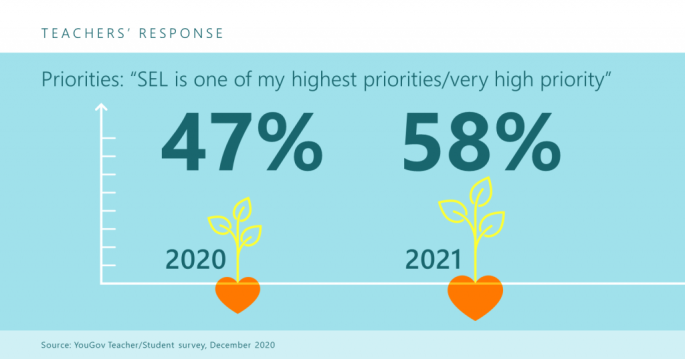Just over a year ago, COVID-19 disrupted the educational journeys of 1.6 billion students around the globe and changed how we live, work, socialize, and learn. Today the world continues to navigate the economic, public health, and humanitarian challenges the pandemic caused. Throughout the disruptions, the incredible efforts of K-12 teachers and higher education faculty and staff have rapidly accelerated innovations and advances in hybrid and remote education that seemed years away. Meanwhile, the social-emotional aspect of learning has come into the spotlight.
Educators have long recognized that social-emotional skills are fundamental for academic achievement, creativity, citizenship, and workforce readiness. Research conducted by McKinsey & Company, “The Class of 2030 and life-ready learning,” found that students will be better prepared for future challenges if they have strong social-emotional skills. “Emotion and Cognition in the Age of AI,” a study conducted by the Economist Intelligence Unit, likewise highlighted the importance of emotional well-being for student success, and showed that approaches to support it are in high demand but low supply. A majority of teachers (64 percent) wanted to support student well-being through social-emotional learning (SEL), but they felt they lacked resources and time to do so.
Now, after a year of disruption and change, a new survey from YouGov shows that teachers consider social-emotional learning an even higher priority than ever before.

than ever before.
As education is being reimagined for the future, education institutions are bringing several key elements together into a holistic approach, the “5S framework,” that:
- prioritizes student centricity
- focuses on critical skills
- promotes social learning
- provides a safe and secure environment
- is scalable and can reach hundreds, thousands, and millions of students
To help students navigate the challenges of remote and hybrid learning, teachers report that they need information about what complexities students face, their emotional state, and what motivates them.

Education technology can help teachers connect with and better understand their students, as well as facilitate students’ development of social-emotional skills.
Communication tools such as Flipgrid and Microsoft Teams are social by design, secure, and provide creative and fun ways for students to express themselves. Features in Teams such as Praise badges give teachers and students more ways to recognize and celebrate one another, Education Insights helps teachers and educators understand and respond to student needs, and Reflect in Teams helps students to identify and label their emotions.
Reflect can build students’ emotional vocabulary and improve their ability to recognize and understand how their emotions may impact their learning. In addition, it can help teachers better identify the needs of individual students.
Starting in April, educators will be able to easily post Reflects and see classroom responses over time through Education Insights.
In addition to Microsoft Teams, there are other best practices, Microsoft partner solutions, and strategies to support social-emotional learning. You can visit the Microsoft Education social and emotional learning page, where you’ll find the SEL Learning Path as well as ideas for using products like Flipgrid and Minecraft Education Edition in remote, hybrid, or in-person learning environments. Flipgrid fosters creative discussion and helps students express themselves through video in an engaging social environment. Using Minecraft Education Edition, students identify their strengths, learn to negotiate with others, and develop leadership skills. Mindful Knight, a freely available Minecraft Education Edition world, teaches specific mindfulness strategies in an immersive setting.

For more best practices and to celebrate the incredible work of teachers and leaders who are transforming education, join us at Microsoft E2 | Education Exchange. Everyone is invited!
We’re excited to have Andreas Schleicher, Director for the Directorate of Education and Skills for the OECD, opening the second day of the event by sharing some of the latest research on social-emotional learning. And after his presentation, you’ll have the opportunity to further your professional development with tracks led by Microsoft Innovative Educator Experts and Microsoft Showcase School leaders. The student engagement and well-being track explores topics including creating virtual field trips with Flipgrid, keeping kids secure online, and how you can support SEL with Microsoft tools. Learn more and register to be a part of it!
And because parents, guardians, and families are a critical part of students’ learning journey, teachers can direct them to the parent, family, and guardian’s guide for a deeper understanding of the importance of SEL.
The future is unpredictable. Social-emotional skills help us better navigate complexity, ambiguity and change, and minimize the negative effects of disruption. The changes of the past year have highlighted the importance of personal connection, accelerated the integration of technology in the classroom, and amplified the role of teachers. It’s encouraging to see the dedication to moving learning forward to a future where all students have the opportunity, support, and tools to be creative, confident, and optimistic learners, realizing their full potential. Thank you for your commitment to learners everywhere and for being part of the Microsoft Education community!
The post Navigating disruption: Spotlight on social-emotional learning first appeared on Microsoft EDU.









